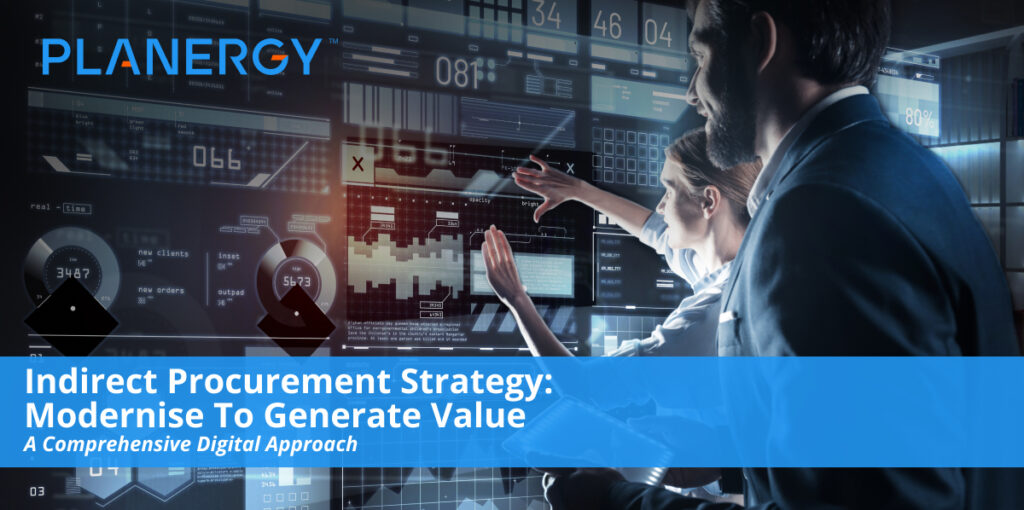As traditional paradigms for procurement fall to the wayside in favor of data-driven models focused on value generation and continuous improvement, embracing digital transformation has become an essential tactic.
And for procurement professionals who are looking to begin or enhance the process of centering procurement as a value center, one of the most effective applications of digital technologies is optimizing indirect procurement.
To be effective, revamping your indirect procurement strategy requires a blend of powerful digital tools, process optimization, and investment in change management. Fortunately, your procurement team can put all three to work with the right techniques and a proactive approach.
Why You Need a New Indirect Procurement Strategy
Historically, indirect procurement has been more difficult to optimize than its direct counterpart.
The latter received the lion’s share of attention and resources because it dealt with production materials, components, finished goods, and production-related services, and consequently had a much larger perceived impact on essential business processes and the overall profitability and performance of an organization.
In addition, indirect spend was often opaque, plagued by inefficient and needlessly complex category management, and a poorly optimized supply chain, especially compared to direct spend.
This led to the widespread use of an indirect spend management model largely focused on capturing savings through price-based sourcing and implementing “damage control” by eliminating waste and redundancies when possible.
Procurement has, in turn, long been viewed as a cost management center at best within many businesses, and at worst a necessary evil that contributed little to a healthy bottom line.
Yet, with digital disruption bringing new tools, technologies, and techniques into play, it has become clear that indirect procurement—which can account for between 25% and 40% of a company’s total spend—can be, with the right approach, a rich source of both savings and value creation.
Indirect procurement is now about much more than office supplies or maintenance, repairs, and operations (MRO) costs; it’s the bedrock of professional services and goods that enable your organization to engage in “the business of doing business.”
Today, companies are pivoting to a data-informed, value-based approach to indirect spend management in order to compete effectively. This approach is built around three core concepts:
- Software tools designed to ease the application of emerging digital transformation technologies, including automation, deep data analytics, artificial intelligence, and centralized, cloud-based data management.
- Best-in-class practices for overall business process management, category management, supply chain management, and supplier relationship management.
- Leveraging digital transformation to shift the role of procurement away from cost savings only and toward the creation of value and savings through both cost avoidance and cost management.
It’s worth noting that while each of these components is individually important to a successful indirect procurement strategy, they must be used strategically and in concert in order to achieve optimal results.
And it clearly pays to do so. A 2017 study by McKinsey & Company found retailers with best-in-class indirect procurement teams averaged 2% – 3% in annual cost savings, cut costs for each full time employee (FTE) in procurement by $1.3 – $1.5 million, and generated a return on investment (ROI) of between 12:1 and 15:1 on their indirect procurement dollar.
Today’s businesses are pivoting to a data-informed, value-based approach to indirect spend management in order to compete effectively.
Revitalizing and Optimizing Indirect Procurement
Applying the three-fold, integrated approach when crafting your indirect procurement management requires a deep and nuanced understanding of your supply chain and supplier relationships, your company’s goals for competitiveness and profitability, and the practices and tools required to streamline your processes for optimal performance and ROI.
Digital Software Tools
When you’re tracking transactions in order to calculate your total indirect costs, these tools provide accurate, complete, and transparent spend data.
They also support spend analysis used to harvest actionable insights—and the evaluation of your processes through the use of key performance indicators (KPIs) and other metrics to support continuous improvement across your entire procurement function and beyond.
The most important tool in your indirect procurement kit is a comprehensive procurement and AP automation solution.
Best-in-class options such as PLANERGY:
- Centralize and consolidate your existing software environment.
- Integrate with your existing accounting system, enterprise resource planning system (ERP system), marketing software, etc. while allowing for the integration of a variety of other discrete data sources.
- Integration also supports elimination of redundant systems and provides standardization of data formats to ensure role-appropriate data is fully accessible by all internal stakeholders.
- Templates and automatic data population further improve accuracy, speed, and consistency while minimizing the need for human intervention.
- Provides intuitive and accessible tools for radically improved, data-driven category management, spend management, supply chain management, and supplier relationship management.
- Automated workflows can be fully customized with context-sensitive contingencies to eliminate roadblocks, delays, and errors.
- Data analysis provides actionable insights procurement professionals can use to negotiate better pricing and terms, form strategic partnerships with preferred suppliers, and streamline the supply chain while still providing adequate risk reduction and ensuring business continuity in the face of powerful supply chain disruptions such as COVID-19 pandemic.
- Provide automation, analysis, and artificial intelligence that directly support continuous improvement, process optimization, change management, and the eventual implementation of digital transformation enhancements across your entire organization.
Other digital tools, such as physical objects integrated into your procurement workflows via the Internet of Things (IoT), digital twins, etc. can be added to provide an even richer datasphere and allow the machine learning algorithms to further refine their performance in pursuit of value creation.
Embracing digital transformation also makes it easier to integrate supplier systems with your own.
In addition to internal controls via guided buying, category management, etc., best-in-class organizations provide vendor portals to provide a direct source of always up-to-date vendor data, including punch-out catalogs.
Best Practices and Process Optimization
Having the tools you need is only the beginning. The procurement function also needs to establish, follow, and enforce best practices to ensure everyone in the organization understands not only the need for these changes, but how their actions contribute to generating value and savings for the company.
- Zero-based budgeting—in which every dollar spent must be justified every year or financial period—ensures tight control over spend. Integration with a comprehensive procurement software solution makes it easy to capture and analyze spend data, along with data from other sources connected to the main system, to create accurate, context-aware, and strategically valuable forecasts and budgets.
- A fully automated procure-to-pay (P2P) process—again, supported by a comprehensive purchasing solution—eliminates many of the most common pain points associated with spend management.
- Automation of high-volume, tedious, and low-value tasks improves speed and accuracy while eliminating human error and freeing staff to apply their time and talents to more strategic tasks, such as supplier relationship management.
- Guided buying and advanced category management ensure maverick spend and invoice fraud—two of the most egregious sources of waste, risk, and lost value in indirect expenditures—are also greatly reduced or eliminated.
- Automatic three-way matching further speeds processing time, improving accounts payable workflows and providing greater versatility for payment and cash flow management.
- Artificial intelligence in general (and machine learning in particular) via robotic process automation allow for iterative, self-guided continuous improvement to capture more savings and value.
- Data can be used to set and track KPIs to monitor and improve everything from supplier performance and contract compliance to detailed spend performance by individual projects, spend categories, or business units.
- Data is available for analysis and manipulation in real time, with role-appropriate, mobile-friendly access from a variety of platforms and devices.
- Integration of procurement with finance is especially valuable when supplier systems are also integrated with the primary procurement solution. Both spend and performance data can be readily tracked and analyzed from internal and external sources, and then contextualized further through the lens of industry and market intelligence to develop strategic spending and sourcing initiatives.
Auditing is also improved, since data is automatically cross-checked and all transactions are automatically captured and made available to both procurement and accounting. Cross-functional analysis can reveal hitherto concealed opportunities to more effectively manage cash flow, develop new products with key suppliers, or expand the role of a preferred supplier with new materials, components, or services.
Finally, by directly connecting procurement to finance, senior management has clear and immediate access to data analytics and dashboards that demonstrate cost savings as well as value creation through process improvement, competitive advantage through partnerships and shared initiatives, etc. - Proactive change management is crucial to securing full buy-in at all levels of your organization. Shifting procurement in general and, more specifically, indirect procurement strategy in particular, as value creation tools for your company begins with education and training.
When developing your indirect spend management strategies, be prepared to demonstrate measurable value for the C-Suite. Securing top-level buy-in helps set the stage for company-wide adoption—the chief financial officer (CFO), for example, will prove invaluable in securing and implementing a P2P system and associated integration of procurement and finance. Provide educational materials directly establishing a connection between new systems and processes and improved competitive performance, greater cost savings, or a stronger bottom line.
It will be helpful to identify and train cheerleaders and champions for the new system and workflows, and allow them to provide advice and guidance to staff across the rest of the company.
Also, choose a software supplier who understands the need for change management, and invest in training before, during, and after the implementation of new processes and tools to make sure everyone understands:- Their role in the hierarchy.
- What tools are available and how to use them.
- Compliance requirements for internal controls.
- The ways in which improving indirect spend management will help improve other business-critical processes (including direct procurement) and aid the company in reaching its goals for competitiveness, profits, and innovation.
Tame Indirect Spend to Generate Lasting Value
Say goodbye to rock-bottom pricing and scattered sourcing.
Leading procurement professionals know that an effective indirect procurement strategy represents a substantial opportunity to harvest insights, implement cost reductions, and generate value that meets or even exceeds the expectations set by internal stakeholders.
Invest in eProcurement tools, prioritize continuous improvement of procurement processes and take a proactive approach to supplier relationship management and spend category management.
By doing so, your procurement team will achieve indirect spend management that’s fully transparent, well-organized, and generating both soft and hard value for your organization.




